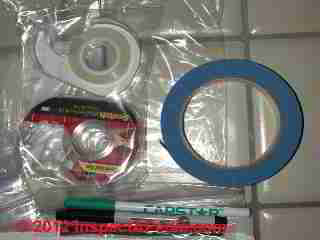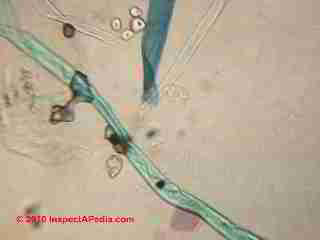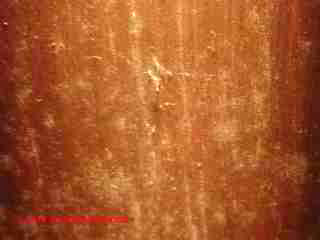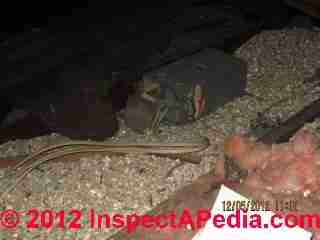 Dust Sample Types
Dust Sample Types
Old Building Dust vs Recent Building Dust - locations & uses
- POST a QUESTION or COMMENT about how to collect indoor dust samples for particle identification and indoor air quality investigation
Dust samples may focus on "old dust" or "recent dust" found in buildings or on building surfaces.
This article defines old building dust, recent building dust, where each type of dust may be found, and why we may want to collect and examine old dust or recent dust in buildings.
The thick dust shown in our page top photo is probably an "old dust" accumulation.
InspectAPedia tolerates no conflicts of interest. We have no relationship with advertisers, products, or services discussed at this website.
- Daniel Friedman, Publisher/Editor/Author - See WHO ARE WE?
Recent vs Old Building Dust: Definitions, Locations, Uses in Indoor Environmental Testing
At DUST SAMPLING PROCEDURE we discuss whether or not one should be testing for problem dust articles at all? So should we be collecting and testing building dust?
Probably not: If the building IAQ question is simply about mold identification, and you already see mold on indoor surfaces, NO mold testing is needed to just to confirm that mold is present in the building and that cleanup is needed
Sure, it might be just cosmetic mold but for small mold cleanup jobs testing is not normally appropriate.
Maybe yes: But if you need to identify the contents of dust, for example to help track down possible sources of building dust particles, or to screen for problem particles such as dust mite fecals, insect fragments, animal dander or hair, soot, fiberglass, etc., or if a large mold remediation project is planned, tests may be needed for project control.
SeeMOLD TEST vs. PROBLEM DIAGNOSIS
Dust sampling theory: usefulness & definitions of "old dust" and "recent dust" in buildings & where these are found
The following description of "old dust" and "recent dust" are my subjective opinion based on experience and are intended to supplement the building settled dust sampling method discussed at MOLD TEST KITS - how to collect settled dust from individual or multiple surfaces using clear adhesive tape as a means to characterize what particles have been in building air over time.
Also see VACUUM CASSETTE FILTER SAMPLE TESTS for DUST / MOLD - collecting settled building dust from one or multiple surfaces using vacuum cassettes.
Definition, Location, & Usefulness of Collecting "old" building dust
Old dust represents particles settling out of building air a time period of weeks, months, years, or dust conditions before, or at the end of a recent demolition, renovation, or cleanup project.
Even after recent cleaning, old building dust can often be found in locations rarely cleaned such as horizontal trim over a door, on window muntins or blinds, under radiators, etc.
An old dust sample is useful to get an idea of the historically dominant particles present in a building and to screen for unusual particles that should not be there. The common dominant particles in most residential buildings are fabric fibers, skin cells, often starch granules (photo above left) and at lower levels, typical airborne mold, dust mite fecals and similar material.
Definition, Location, & Usefulness of Collecting "recent" building dust
Recent dust represents particles settling out of building air only recently, such as dust falling onto a surface that we know was recently cleaned completely.
While statistically less robust since it represents only a shorter time interval (typically days or weeks), recent dust can serve as a screen to look for evidence that problem particles remain in a building at actionable levels - or not.
Just how much time needs to elapse between building cleaning and the collection of a meaningful sample of recent building dust varies from hours to a month, depending on building materials, contents, occupancy, HVAC systems, cleanliness of adjoining areas and similar factors.
Key is to collect recent dust from a surface that we know (and perhaps confirmed by earlier sampling) was previously cleaned and very low in settled dust particles at the start of the test period.
Using a reader's question (see FAQs in this article: VERMICULITE INSULATION) as an example, if loose-fill vermiculite insulation were accidentally spilled in a building and then cleaned properly, we should find only comparatively low levels of vermiculite particles (or very low levels of asbestos if the vermiculite insulation originally contained asbestos dust and fragments).
In this case an old dust sample might find high levels, even dominant levels of vermiculite insulation in building areas near the spill or where HVAC systems transported building dust from the spill to other areas. A recent dust sample should find vermiculite fragments only low levels, perhaps just at incidental levels, and certainly not dominant level.
Interestingly, following a demolition and cleaning project, for example when mold contamination has been removed, it would be expected to find incidental levels of the original problem mold genera/species. Finding zero levels of such particles might raise question about the sampling approach.
Based on the theory above, which in turn is based on my field and lab experience in testing buildings for particulate contaminants, if you were worried that an original vermiculite spill had not been adequately cleaned, *or* if you wanted to know if the original vermiculite spill included asbestos, you might want to collect both a recent-dust sample and an old dust sample for comparison.
If, however, the cleanup was professionally conducted and post-cleanup testing was already performed properly, and if those steps indicated no problem remaining, in my *opinion* further testing would not be justified unless a new reason for further investigation is apparent. (Examples of such reasons are
at MOLD / ENVIRONMENTAL EXPERT, HIRE ?
and also at MOLD TEST REASONS.
If you have questions about the best particle sample collection procedure for your situation, Contact Us by email.
...
Continue reading at DUST SAMPLING PROCEDURE or select a topic from the closely-related articles below, or see the complete ARTICLE INDEX.
Or see these
Articles on building dust or house dust
- HOUSE DUST ANALYSIS
- AIRBORNE PARTICLE ANALYSIS METHODS
- ALLERGENS in BUILDINGS
- CARPET DUST IDENTIFICATION
- AIRBORNE PARTICLE COUNT VARIATION CAUSES
- AIRBORNE PARTICLE COUNT VARIATION EXTENT
- AIRBORNE PARTICLE COUNTS in DUCTWORK
- AIRBORNE PARTICLE COUNTS vs SAMPLER HEIGHT
- AIRBORNE PARTICLE COUNTS vs WINDOWS, DOORS
- AIRBORNE PARTICLE & MOLD LEVELS in DUCTWORK
- CONCRETE DUST & ODORS
- DUST ANALYSIS for FIBERGLASS
- DUST, HVAC CONTAMINATION STUDY
- DUST SAMPLE TYPES we distinguish between "old house dust" and "recent house dust" which in turn can aid in building indoor air quality investigation diagnosis
- DUST SAMPLING PROCEDURE
- TEST KIT for DUST, MOLD, PARTICLES: INSTRUCTIONS
- FIBER & HAIR IDENTIFICATION
- FIBERGLASS AIR DUCT MOLD TEST
- FIBERGLASS PARTICLE CONTAMINATION TEST
- HOUSE DUST CHEMICAL CONTAMINANTS
- HOUSE DUST COMPONENTS
- HOUSE DUST PARTICLE PHOTOS - a photo tour of what we found in dust from a London loft.
- HVAC DUST CONTAMINATION STUDY - what do we find in dust in a heating or air conditioning system?
- LEAD POISONING HAZARDS GUIDE
- USES of AIRBORNE PARTICLE SAMPLING
Suggested citation for this web page
DUST SAMPLE TYPES at InspectApedia.com - online encyclopedia of building & environmental inspection, testing, diagnosis, repair, & problem prevention advice.
Or see this
INDEX to RELATED ARTICLES: ARTICLE INDEX to BUILDING ENVIRONMENT
Or use the SEARCH BOX found below to Ask a Question or Search InspectApedia
Or see
INDEX to RELATED ARTICLES: ARTICLE INDEX to BUILDING INDOOR AIR QUALITY IAQ
Or use the SEARCH BOX found below to Ask a Question or Search InspectApedia
Or see
INDEX to RELATED ARTICLES: ARTICLE INDEX to MOLD CONTAMINATION & REMEDIATION
Or use the SEARCH BOX found below to Ask a Question or Search InspectApedia
Ask a Question or Search InspectApedia
Try the search box just below, or if you prefer, post a question or comment in the Comments box below and we will respond promptly.
Search the InspectApedia website
Note: appearance of your Comment below may be delayed: if your comment contains an image, photograph, web link, or text that looks to the software as if it might be a web link, your posting will appear after it has been approved by a moderator. Apologies for the delay.
Only one image can be added per comment but you can post as many comments, and therefore images, as you like.
You will not receive a notification when a response to your question has been posted.
Please bookmark this page to make it easy for you to check back for our response.
IF above you see "Comment Form is loading comments..." then COMMENT BOX - countable.ca / bawkbox.com IS NOT WORKING.
In any case you are welcome to send an email directly to us at InspectApedia.com at editor@inspectApedia.com
We'll reply to you directly. Please help us help you by noting, in your email, the URL of the InspectApedia page where you wanted to comment.
Citations & References
In addition to any citations in the article above, a full list is available on request.
- [1] "Official Compilation of Codes, Rules and Regulations of the State of New York, Title 8. Education Department, Chapter II. Regulations of the Commissioner, Subchapter J. Buildings and Transportation, Part 155. Education Facilities", New York State Department of Education, web search 4/11/2012, original source:
http://www.p12.nysed.gov/facplan/Laws_Regs/8NYCRR155.htm - [2] "Section 155.2 Construction and remodeling of school district facilities " except from above, op.cit.
- Kansas State University, department of plant pathology, extension plant pathology web page on wheat rust fungus: see http://www.oznet.ksu.edu/path-ext/factSheets/Wheat/Wheat%20Leaf%20Rust.asp
- A BRIEF GUIDE to MOLD, MOISTURE, and YOUR HOME, [PDF] U.S. Environmental Protection Agency US EPA - includes basic advice for building owners, occupants, and mold cleanup operations. See http://www.epa.gov/mold/moldguide.htm
- US EPA - MOLD REMEDIATION in SCHOOLS & COMMERCIAL BUILDINGS - - US EPA
- US EPA - UNA BREVA GUIA a MOHO / HONGO - en Espanol
- "IgG Food Allergy Testing by ELISA/EIA, What do they really tell us?" Sheryl B. Miller, MT (ASCP), PhD, Clinical Laboratory Director, Bastyr University Natural Health Clinic - ELISA testing accuracy: Here is an example of Miller's critique of ELISA - www.betterhealthusa.com/public/282.cfm - Townsend Letter for Doctors and Patients
The critique included in that article raises compelling questions about IgG testing assays, which prompts our interest in actually screening for the presence of high levels of particles that could carry allergens - dog dander or cat dander in the case at hand.
- www.tldp.com/issue/174/IgG%20Food%20Allergy.html - contains similar criticism in another venue but interestingly by the same author, Sheryl Miller. Sheryl Miller, MT (ASCP), PhD, is an Immunologist and Associate Professor of Basic and Medical Sciences at Bastyr University in Bothell, Washington. She is also the Laboratory Director of the Bastyr Natural Health Clinic Laboratory. - Allergens: Testing for the level of exposure to animal allergens is discussed at http://www.animalhealthchannel.com/animalallergy/diagnosis.shtml (lab animal exposure study is interesting because it involves a higher exposure level in some cases
- Allergens: WebMD discusses allergy tests for humans at webmd.com/allergies/allergy-tests
- Fiberglass carcinogenicity: "Glass Wool Fibers Expert Panel Report, Part B - Recommendation for Listing Status for Glass Wool Fibers and Scientific Justification for the Recommendation", The Report on Carcinogens (RoC) expert panel for glass wool fibers exposures met at the Sheraton Chapel Hill Hotel, Chapel Hill, North Carolina on June 9-10, 2009, to peer review the draft background document on glass wool fibers exposures and make a recommendation for listing status in the 12th Edition of the RoC. The
National Institute of Environmental Health Sciences is one of the National Institutes of Health within the U.S. Department of Health and Human Services. The National Toxicology Program is headquartered on the NIEHS campus in Research Triangle Park, NC. The National Institute of Environmental Health Sciences is one of the National Institutes of Health within the U.S. Department of Health and Human Services. The National Toxicology Program is headquartered on the NIEHS campus in Research Triangle Park, NC.
Following a discussion of the body of knowledge, the expert panel reviewed the RoC listing criteria and made its recommendation. The expert panel recommended by a vote of 8 yes/0 no that glass wool fibers, with the exception of special fibers of concern (characterized physically below), should not be classified either as known to be a human carcinogen or reasonably anticipated to be a human carcinogen.
The expert panel also recommended by a vote of 7 yes/0 no/1 abstention, based on sufficient evidence of carcinogenicity in well-conducted animal inhalation studies, that special-purpose glass fibers with the physical characteristics as follows longer, thinner, less soluble fibers (for 1 example, > 15 μm length with a kdis of < 100 ng/cm2/h) are reasonably anticipated to be a human carcinogen for the listing status in the RoC. The major considerations discussed that led the panel to its recommendation include the observations of tumors in multiple species of animals (rats and hamsters). Both inhalation and intraperitoneal routes of exposure produced tumors, although inhalation was considered more relevant for humans.
- World Health Organization International Agency for Research on Cancer - IARC Monographs on the Evaluation of Carcinogenic Risks to Humans - VOL 81 Man-Made Vitreous Fibers, 2002, IARCPress, Lyon France, pi-ii-cover-isbn.qxd 06/12/02 14:15 Page i - World Health Organization, 1/21/1998. - Fiberglass insulation is an example of what IARC refers to as man made vitreous fiber - inorganic fibers made primarily from glass, rock, minerals, slag, and processed inorganic oxides. This article provides enormous detail about fiberglass and other vitreous fibers, and includes fiberglass exposure data.
- WHO- World Health Organization - IARC MONOGRAPHS ON THE IDENTIFICATION OF CARCINOGENIC HAZARDS TO HUMANS (large PDF over 6MB)
https://publications.iarc.fr/ENG/Monographs/vol81/mono81-6A.pdf - article details
https://publications.iarc.fr/ENG/Monographs/vol81/mono81-6C.pdf - studies of cancer in experimental animals in re vitreous fibers such as fiberglass;
https://publications.iarc.fr/ENG/Monographs/vol81/mono81-6E.pdf - summary of data reported & evaluation
https://publications.iarc.fr/ENG/Monographs/vol81/mono81-6F.pdf for the article references
To search the IARC monographs on various environmental concerns and carcinogens, use https://publications.iarc.fr/ENG/Monographs/PDFs/index.php - Fifth Kingdom, Bryce Kendrick, ISBN13: 9781585100224, - we recommend the CD-ROM version of this book. This 3rd/edition is a compact but comprehensive encyclopedia of all things mycological. Every aspect of the fungi, from aflatoxin to zppspores, with an accessible blend of verve and wit. The 24 chapters are filled with up-to-date information of classification, yeast, lichens, spore dispersal, allergies, ecology, genetics, plant pathology, predatory fungi, biological control, mutualistic symbioses with animals and plants, fungi as food, food spoilage and mycotoxins.
- In addition to citations & references found in this article, see the research citations given at the end of the related articles found at our suggested
CONTINUE READING or RECOMMENDED ARTICLES.
- Carson, Dunlop & Associates Ltd., 120 Carlton Street Suite 407, Toronto ON M5A 4K2. Tel: (416) 964-9415 1-800-268-7070 Email: info@carsondunlop.com. Alan Carson is a past president of ASHI, the American Society of Home Inspectors.
Thanks to Alan Carson and Bob Dunlop, for permission for InspectAPedia to use text excerpts from The HOME REFERENCE BOOK - the Encyclopedia of Homes and to use illustrations from The ILLUSTRATED HOME .
Carson Dunlop Associates provides extensive home inspection education and report writing material. In gratitude we provide links to tsome Carson Dunlop Associates products and services.





